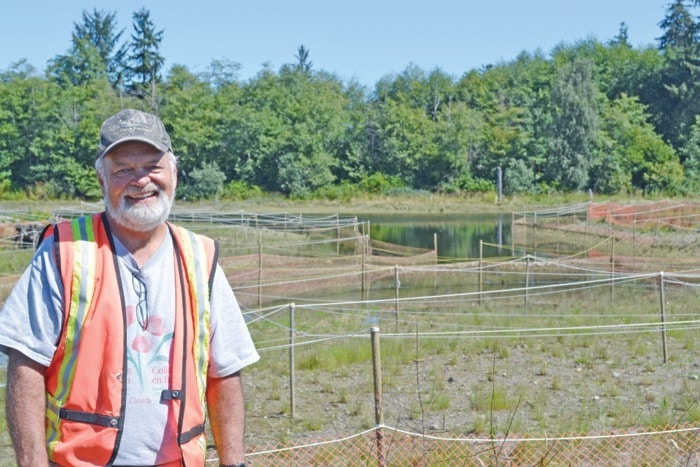What was once a flat, gravelly, dead zone is well on the way back to its natural state.
Connected to the Campbell River Estuary, the area that was once an old sawmill site looks very different than it did just a year ago.
Now, instead of a lifeless gravel area, there’s a creek running through the middle to meet up with Baikie Slough, and new plants are being protected by plastic orange fencing.
“You can see it’s working,” said project manager Jim Van Tine. “You can certainly notice a difference in the vegetation because before it was a flat lot.”
The two acre site, which is located between Robinson Rd. and E and B Helicopters, belonged to Ocean Blue Cedar Products, but was bought by the Nature Conservancy of Canada in 2007 after the mill closed.
In Aug. 2010 heavy machinery work began by moving gravel and soil to re-create the creek and make islands.
Back when the sawmill was in operation, the creek had been diverted and ran through a culvert for the length of the property before pouring out into the slough.
Van Tine worked to ‘daylight’ the creek by moving it out of the long culvert and back to its original location, which goes through a small culvert under the highway on its way from Campbell River, and then comes through the middle of the property on its way to meet the slough.
Then, in the fall he and his crew planted native plants along the riparian zone, which runs along the tideline of the slough.
And in February, a crew of about 45 volunteers came out to plant natural marsh grass in the tidal area of the slough.
The marsh grasses are what’s protected by the fences because the Canadian geese “eat them like candy,” according to Van Tine.
“So now we’ve got numerous bushes and plants, and we’ve got a marsh growing, and we’ve got a creek flowing,” said Van Tine.
Although the marsh grasses are just short clumps right now, Van Tine said that within three years it will be fully developed, and in the peak growing season it will be chest high.
According to Van Tine, the marshes act like compost when they decompose, meaning that small bugs feed on the rotting material, then big bugs feed on them, and then fish feed on the bigger bugs, and then birds feed on the fish, and so it goes.
“The primary object here is fish but when we do a fish project a lot of other things benefit too,” explained Van Tine. “Without these marshes the estuary would be far, far less productive.”
Although Van Tine said it’s basically impossible to tell how many more fish will be in Campbell River thanks to the rebuilt area, small coho salmon can be seen swimming in a pool area of the creek.
Van Tine said the project should take about three to five years to be fully established, and points out that these kinds of projects take time.
“It takes patience,” said Van Tine. “Look here and you can see these little trees,” he added as he pointed to small trees running along the creek. “They’re four or five feet high and they’re all kind of spindly, but in 20 years you’ll be able to sit underneath them.”
